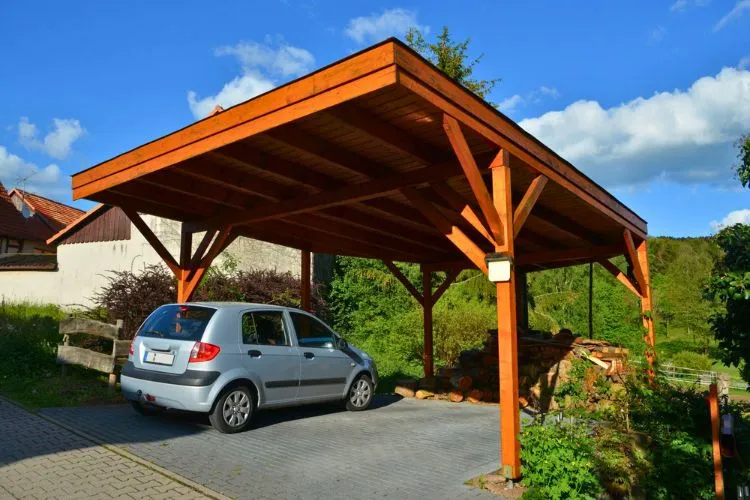A carport can be a valuable addition to your property. It protects vehicles from the elements and can even enhance the overall value of your home. So, do you need a permit to build a carport?
However, before you start building, it’s crucial to understand the permit requirements. This guide will explore when and why you might need a permit for your carport.

Contents
Understanding Building Permits
Building permits are official approvals issued by local government agencies. They allow the construction, expansion, or alteration of buildings on your property.
Permits ensure that all structures comply with current building codes, zoning laws, and safety standards. These laws vary by location but generally aim to ensure public safety and community standards.
Building Codes and Regulations
Building codes and regulations are sets of rules that govern how structures must be built. The International Residential Code (IRC) provides a set of standards used by many local jurisdictions.

They address structural integrity, zoning laws, and safety issues. Understanding these codes is essential before starting your carport project.
Do You Need a Permit to Build a Carport?
Whether you need a permit to build a carport depends on several factors. These include the size of the structure, its location on your property, and whether it is attached to your home. Local regulations vary widely:
- Size: In many areas, small carports that do not exceed certain dimensions may not require a permit. However, larger structures typically do.
- Location: Placement on your property can affect permit requirements. For instance, carports built close to property lines may face stricter regulations.
- Attachment: An attached carport usually affects the main home’s structure and might be more likely to require a permit than a detached one.
Applying for a Building Permit
Getting a permit involves several steps. While procedures vary by location, they generally involve the following:
- Preparation: Gather necessary information about your project. You might need a site plan, construction details, and proof of property ownership.
- Application: Submit your application to the local building authority. This often includes filling out paperwork and providing the specifics of your design.
- Review: The building department will review your plans to ensure they comply with local codes and regulations.
- Fees: Depending on your project and location, you may need to pay a fee when submitting your application.
- Inspection: After obtaining a permit, an inspector might need to check the construction site both during and after construction to ensure it meets all regulations.
Local vs. State vs. Federal Regulations
Navigating through the maze of regulations for building a carport involves understanding the interplay between local, state, and federal laws. Local regulations, typically enforced by city or county authorities, are the most immediate concern for homeowners.
These rules can dictate everything from the carport’s size and placement to the materials used and aesthetic considerations, ensuring they align with neighborhood standards and zoning laws.

State regulations may introduce broader requirements related to structural integrity and safety standards, possibly affecting design aspects like wind load and snow bearing capacity. Certain states might also have specific regulations for coastal areas or wildfire-prone zones to mitigate environmental risks.
While federal regulations rarely apply to residential carport constructions directly, they can play a role in areas governed by federal entities or on leased federal land. Additionally, federal regulations may influence materials standards or environmental protections, indirectly affecting local and state regulations.
Understanding each of these regulatory layers is crucial. Homeowners must often navigate local and state requirements simultaneously, ensuring their carport project complies fully from the ground up, avoiding legal complications and ensuring the safety and durability of the structure.
You may also find useful: Can You Use an Arrow Carport in the Winter?
When a Permit is Not Required?
There are specific scenarios where building a carport on your property might not necessitate obtaining a permit, offering a smoother path to completion.
A common exemption relates to size; many local jurisdictions have threshold dimensions below which a structure is considered minor enough not to require oversight. For instance, a carport intended to shelter a single vehicle, taking up minimal square footage, might fall under this category.
Temporary carports are another category often exempt from permitting requirements. Designed to be easily dismantled, these structures provide flexibility without the permanence that typically triggers regulatory scrutiny.
Their nature allows homeowners to add protective vehicle space without the complexity of permanent construction.
Zoning exceptions also play a significant role. In certain rural or less densely populated areas, regulations may be relaxed, acknowledging the reduced impact on neighbors and municipal services.
However, it’s crucial to consult local building authorities before proceeding, as interpretations of “temporary” or size exemptions can vary widely. Ignorance of such nuances can lead to enforcement actions, even for structures believed to be exempt.
Frequently Asked Questions (FAQs)
Can I build a carport on any area of my property?
No, you must consider local zoning laws, which can restrict where you can build.
What happens if I build without a permit?
Building without a permit can result in fines, legal action, or the requirement to dismantle the structure.
How long does it take to get a carport permit?
The time varies by location but can take anywhere from a few days to several weeks.
How can I find out if my carport project requires a permit?
The best approach is to contact your local building authority or zoning office. They can provide specific guidelines based on your project’s details, such as size, location, and type of construction.
Pro Tips
Choosing a qualified contractor can streamline the permit process. These professionals understand local laws and can help design a carport that meets legal standards. Here are a few tips:
- Consult Early: Speak with a building inspector before you begin planning. They can offer guidance on requirements and help avoid costly mistakes.
- Ensure Compliance: Always make sure your project adheres to local building codes and safety guidelines. Non-compliance can lead to issues with insurance and property value.
Conclusion:
Understanding whether you need a permit to build a carport is essential. It ensures your project complies with local laws and regulations, helping to avoid future problems.
Planning thoroughly and consulting professionals can lead to a successful and legally sound project. Follow this guide to navigate the complexities of building permits for a smooth experience.

Sergio Gomes, a passionate advocate for outdoor living and the male voice behind Shades Authority. With years of experience, Sergio is your trusted source for expert insights on gazebos, pavilions, cabanas, pergolas, and all things outdoor shade solutions. Join him on a journey to transform your outdoor spaces into stunning, functional retreats
